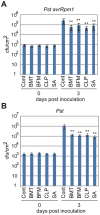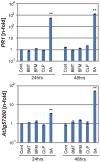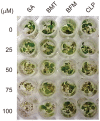Diuretics prime plant immunity in Arabidopsis thaliana
- PMID: 23144763
- PMCID: PMC3483147
- DOI: 10.1371/journal.pone.0048443
Diuretics prime plant immunity in Arabidopsis thaliana
Abstract
Plant activators are agrochemicals that activate the plant immune system, thereby enhancing disease resistance. Due to their prophylactic and durable effects on a wide spectrum of diseases, plant activators can provide synergistic crop protection when used in combination with traditional pest controls. Although plant activators have achieved great success in wet-rice farming practices in Asia, their use is still limited. To isolate novel plant activators applicable to other crops, we screened a chemical library using a method that can selectively identify immune-priming compounds. Here, we report the isolation and characterization of three diuretics, bumetanide, bendroflumethiazide and clopamide, as immune-priming compounds. These drugs upregulate the immunity-related cell death of Arabidopsis suspension-cultured cells induced with an avirulent strain of Pseudomonas syringae pv. tomato in a concentration-dependent manner. The application of these compounds to Arabidopsis plants confers disease resistance to not only the avirulent but also a virulent strain of the pathogen. Unlike salicylic acid, an endogenous phytohormone that governs disease resistance in response to biotrophic pathogens, the three diuretic compounds analyzed here do not induce PR1 or inhibit plant growth, showing potential as lead compounds in a practical application.
Conflict of interest statement
Figures








Similar articles
-
Ethylene Response Factor ERF11 Activates BT4 Transcription to Regulate Immunity to Pseudomonas syringae.Plant Physiol. 2019 Jun;180(2):1132-1151. doi: 10.1104/pp.18.01209. Epub 2019 Mar 29. Plant Physiol. 2019. PMID: 30926656 Free PMC article.
-
CATION-CHLORIDE CO-TRANSPORTER 1 (CCC1) Mediates Plant Resistance against Pseudomonas syringae.Plant Physiol. 2020 Feb;182(2):1052-1065. doi: 10.1104/pp.19.01279. Epub 2019 Dec 5. Plant Physiol. 2020. PMID: 31806735 Free PMC article.
-
Multilayered Regulation of Ethylene Induction Plays a Positive Role in Arabidopsis Resistance against Pseudomonas syringae.Plant Physiol. 2015 Sep;169(1):299-312. doi: 10.1104/pp.15.00659. Epub 2015 Aug 11. Plant Physiol. 2015. PMID: 26265775 Free PMC article.
-
Regulation and Functions of ROP GTPases in Plant-Microbe Interactions.Cells. 2020 Sep 2;9(9):2016. doi: 10.3390/cells9092016. Cells. 2020. PMID: 32887298 Free PMC article. Review.
-
Molecular complexity of quantitative immunity in plants: from QTL mapping to functional and systems biology.C R Biol. 2024 May 21;347:35-44. doi: 10.5802/crbiol.153. C R Biol. 2024. PMID: 38771313 Review.
Cited by
-
Oxicam-type non-steroidal anti-inflammatory drugs inhibit NPR1-mediated salicylic acid pathway.Nat Commun. 2021 Dec 15;12(1):7303. doi: 10.1038/s41467-021-27489-w. Nat Commun. 2021. PMID: 34911942 Free PMC article.
-
The Past, Present, and Future of Plant Activators Targeting the Salicylic Acid Signaling Pathway.Genes (Basel). 2024 Sep 23;15(9):1237. doi: 10.3390/genes15091237. Genes (Basel). 2024. PMID: 39336828 Free PMC article. Review.
-
Plant Cation-Chloride Cotransporters (CCC): Evolutionary Origins and Functional Insights.Int J Mol Sci. 2018 Feb 6;19(2):492. doi: 10.3390/ijms19020492. Int J Mol Sci. 2018. PMID: 29415511 Free PMC article. Review.
-
The pearl millet mitogen-activated protein kinase PgMPK4 is involved in responses to downy mildew infection and in jasmonic- and salicylic acid-mediated defense.Plant Mol Biol. 2015 Feb;87(3):287-302. doi: 10.1007/s11103-014-0276-8. Epub 2014 Dec 20. Plant Mol Biol. 2015. PMID: 25527312
-
Sulfonamides identified as plant immune-priming compounds in high-throughput chemical screening increase disease resistance in Arabidopsis thaliana.Front Plant Sci. 2012 Oct 31;3:245. doi: 10.3389/fpls.2012.00245. eCollection 2012. Front Plant Sci. 2012. PMID: 23118736 Free PMC article.
References
-
- Editorial (2010) How to feed a hungry world. Nature 466: 531–532. - PubMed
-
- Agrios GN (2004) Plant pathology 5th edn. (Academic Press, Harcourt Brace Jonanovich, Publishers, New York).
-
- Oostendorp M, Kunz W, Dietrich B, Staub T (2001) Induced Disease Resistance in Plants by Chemicals. Eur J Plant Pathol 107: 19–28.
-
- Watanabe T, Igarashi H, Matsumoto K, Seki S, Mase S, et al. (1977) The Characteristics of Probenazole (Oryzemate®) for the Control of Rice Blast. J Pestic Sci 2: 291–296.
-
- Nakashita H, Yoshioka K, Yasuda M, Nitta T, Arai Y, et al. (2002) Probenazole induces systemic acquired resistance in tobacco through salicylic acid accumulation. Physiol Mol Plant Pathol 61: 197–203.
MeSH terms
Substances
Grants and funding
LinkOut - more resources
Full Text Sources
Molecular Biology Databases

